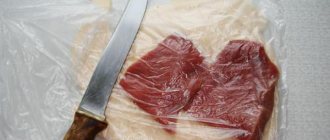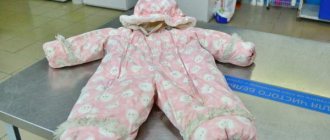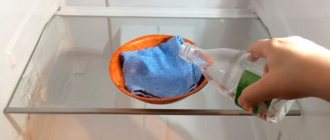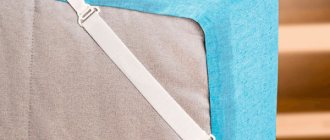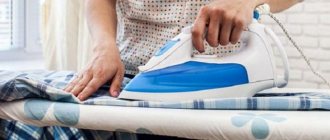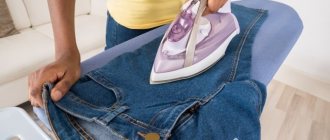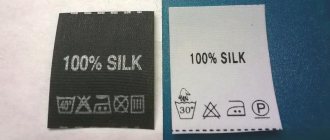Recently, sheets with elastic have become increasingly popular among bedding items. And this is no coincidence, because unlike ordinary sheets, they do not slip during sleep and do not form folds that cause discomfort. In addition, a made bed looks more aesthetically pleasing and beautiful.
But every housewife who has at least once encountered ironing such sheets will say that this is not the easiest task. So, we’ll tell you how to approach this issue correctly, share several proven ironing methods with step-by-step descriptions, and give valuable advice.
Preparation for the process
In order not to complicate the process of ironing a stretch sheet, you need to follow the rules for washing and drying such products, and also carefully prepare your work area.
When washing, remember the following:
- It is convenient to wash a fitted sheet in an automatic washing machine - neither hand washing nor an activator-type machine makes it possible to properly wring out such a voluminous product.
- Do not pack bedding tightly into the drum.
- Use detergents and temperatures appropriate for the type of fabric.
Do you iron sheets with an elastic band?
Of course I don't iron
To properly dry your sheets after washing, follow these recommendations:
- To prevent deep creases from forming on the surface of the sheet, which are then very difficult to smooth out, immediately remove the laundry from the washing machine after completing the washing program.
- Shake and straighten the sheet on all sides, including the corners, and hang it carefully on the dryer.
- Do not overdry the sheets, but rather remove the linen slightly damp - this will make the ironing process easier.
When starting to iron large items, such as a sheet, you need to do the following:
- Make sure your workplace is well lit.
- Adjust the height of the ironing board so that you don't have to bend over - this way you won't get tired for a long time.
- If you don’t have an ironing board, you can use a table after covering it with a non-slip thick cloth.
- An iron with a steam function is required for ironing. Set the correct temperature according to the type of fabric - this is extremely important for a quality result.
- Make sure that the canvas does not contain minor damage. To prevent them from expanding under the influence of heat, they must first be sewn up.
- Clean around your work area, as the heavy cloth will periodically slide onto the floor during the process.
Good to know! If the manufacturer does not indicate the recommended ironing parameters on the label or the tag is lost, then use the following hint - linen is ironed at 200 °C, cotton at 180 °C, and for silk and delicate fabrics the mode is set to no more than 80 °C.
This publication will tell you how to properly iron bed linen after washing with an iron or steamer.
Techniques for ironing sheets
To properly iron a simple sheet, follow these steps:
- The sheet is folded four times with the front side up. The corners of the top and bottom are connected, then folded again, parallel to the resulting fold.
- Having placed the resulting structure on the ironing board, iron the surface without running the iron into the folds. They are not ironed at all, so as not to create unnecessary folds.
- Next, you need to turn the product over and iron it the same way as the first part.
- Then unfold the sheet once and fold it inside again with the ironed side.
- The product is folded perpendicular to the previously made bend and the iron is passed over the unironed surface. The manipulation is also performed twice.
Attention! The sheet should be ironed along the warp thread (from left to right), and not from top to bottom. First of all, iron the existing seams.
Useful tips and tricks
To make the process of ironing a sheet with an elastic band effective and not seem tedious, we will give a few life hacks that will help you achieve a better result:
- During the ironing process, before running the iron over the fabric, you should smooth it with your hands. It is best to slightly stretch the fabric by grasping the ends - this way you can straighten the fabric and easily avoid creases and distortions.
- Do not run the iron along the folds when the sheet is folded several times.
- Allow the ironed sheet to sit for a while and cool, ventilate and dry before folding it and storing it in the closet.
- When washing, add conditioner to the rinse water - this will make the fabric softer and avoid severe creases when ironing.
- Whenever possible, try to iron your fitted sheet when it's slightly damp. This is especially true for cotton products. To moisturize, you can use a spray bottle or the spray function in the iron.
- Some materials are better ironed using damp gauze, which is placed on top when ironing.
- Using steam will get rid of the worst creases.
- Using a steamer or steam generator, you can not only iron very dry sheet fabric well, but also carry out additional disinfection of the product and give it freshness.
- Unlike other options, sheets made of silk or delicate thin fabrics, with the addition of synthetics, as well as satin, are ironed from the wrong side and without wetting. A steamer is also not used.
- Do not run the iron over the same area several times if the fabric has already been ironed.
Attention! Terry fabric becomes rough after ironing, loses its appearance and absorbency, so simply lay the terry sheet on a flat surface after washing, straighten it and let it dry.
Find out which steam generator to choose for your home, for ironing and cleaning, and why the steam generator sprays water instead of steam.
Several step-by-step methods for making a fitted sheet with your own hands
Method one: sew a product with an elastic band onto a mattress measuring 160x200 cm
- The fabric is pre-decorated.
- The pattern is applied directly to the surface of the selected material. If you create a sheet with an elastic band measuring 160x200 cm, add 40 cm on each side.
- The resulting piece of rectangular material is folded in half twice.
- A square is measured at the corners from the edges (40 cm on each side), and then cut out. The resulting rectangle with missing corners is ironed.
- The edges of each square are leveled, folded so that the front side of the material is inside and stitched. The corners are turned out and leveled.
- Before sewing the corner elastic onto the sheet, a fold is made, into which the tension element is pulled. Holes for fixtures in the corners are left at the sewing stage.
- If you want to tighten the tension element around the perimeter of the product, the seam is made along all sides of the product, and not just at the corners.
Method two: product for a mattress 200x200 cm
- The material is folded in half, after which the corners are cut out.
- The removed corners are folded from the wrong side and stitched.
- A double fold is made along the perimeter of the sheet and hemmed. The resulting space is used to thread the tension element.
Method three: step-by-step sewing for beginners
Auxiliary devices for fixing the sheet
Method four: sewing bedding on a children's mattress
- 60 cm + 2 x (10 cm + 2 cm) = 84 cm – width;
- 120 cm + 2 x (10 cm + 2 cm) = 144 cm – length.
Step-by-step guide to sewing a fitted sheet
- After making the pattern (using a ready-made version purchased along with specialized paper publications), the corners in which the squares are placed are folded diagonally and the corner that will run along the intended lines is turned on a machine (overlocker). Excess is carefully removed, as it will interfere in the future. Thus, a hem is made corresponding to the height of the berth.
- The bottom of the fitted sheet for a crib is processed. Provided that the bottom of the product will be hidden by the mattress, it is enough to go over the seams with an overlocker. Additional processing of the bottom requires a larger supply of fabric. The allowance for bending the fittings is calculated in advance and depends on the thickness of the linen fittings used. Sewn-on fittings do not require a large amount of fabric; you will need a hole to thread the tension element into the prepared space.
- After grinding the edges, you should sew in a tension element or thread it into a previously prepared space. To save time and effort, you should use the corner method of sewing in fittings. This method will ensure excellent fixation of the sheet on the mattress, while 25 cm of elastic from each corner is sufficient, instead of the stated 5 m. The fittings are also sewn onto children's products along the entire contour. To do this, the fittings are threaded into the drawstring along the entire length. Ironing such bedding is problematic, and long-term storage in folded form will lead to significant deformation of the fabric and the need for repeated ironing.
Round sheet with elastic band
- With the right side inward, the canvas is folded in half. Measured along the long side 1.3 m, along the short side 0.4 m.
- After repeated folding, the diameter should be at least 0.4 m. At the corners, 0.24 m is measured on each side.
- The main part is ready after cutting the corners.
- Let's move on to the facing. For this, a strip of fabric 0.2 m wide is used, and the length will correspond to the previously taken measurements - 4.2 m (total indicator - 130 + 80 cm x 2).
- Stripes are made.
- The strips are applied to each other and sewn. The allowance will be 50 mm. A linen stitch is used.
- Sticking threads are removed.
- The assembled facing is sewn to the main flap.
- All cuts must be processed with an overlocker or a special (protective) seam using a regular sewing machine.
- A drawstring for fittings is made.
- The edges of the facing are turned up by 10 mm.
- The drawstring is stitched. A small hole is made through which the fittings are then threaded. Its length should be half the diameter of the facing.
- A small pin is used to pull the fittings through.
Is it possible to do it without ironing?
If you constantly don’t have enough time for household chores, then there are several options in which you don’t have to iron the stretch sheets:
- The easiest way is to simply pull the sheet onto the mattress after drying and leave it to unfold naturally in this state. Of course, not immediately, but the surface will be smoothed out, although it will not be perfectly smooth.
- Use terry sheets with elastic. Of course, drying them is not very convenient, since this requires a large surface, but they do not need to be ironed. Just use a gentle wash cycle and fabric softener, and fold these items correctly and get great results.
- If you still want your sleeping surface to look neat and perfectly smooth, but you want to give up ironing, then choose fitted sheets made from modern, wrinkle-resistant materials. For example, bamboo fiber can retain its shape for up to 500 washes.
Is it possible to iron directly on the mattress?
If you need to quickly iron your clothes, this method can help. Hot temperatures and steam can damage the mattress, so if it is expensive and has an orthopedic base, it is better not to use this method.
The method of ironing on a mattress is simple: pull the sheet over the edges of the mattress, pass the iron over the surface of the fabric. It is better to use an iron at a reduced temperature. Ironing in this way requires almost dry fabric. Humidity increases the temperature of the iron and is absorbed into the mattress, deteriorating its quality.
You should not use this method often; the quality of the mattress will deteriorate every time.
How to fold a fitted sheet so it doesn't wrinkle?
The design of the stretch sheet is such that simply folding it as usual will not work. Otherwise, one product will take up the entire shelf and quickly become wrinkled.
To avoid spoiling the successful ironing result by storing it in a closet, use the following method of folding a sheet with an elastic band:
- The cooled sheet is unrolled and first the lower corner is straightened with your fingers, and then the upper corner opposite it.
- Connect two corners in one hand so as to put one corner into the other.
- Using your free hand, add the remaining two corners, placing one on top of the other one at a time.
- We carefully straighten the resulting rectangle around the perimeter and fold it several times, like a regular sheet.
- As a result, you should get an evenly folded product with the edges tucked into each other.
Although this method looks complicated at first glance, you only have to try it once and understand the technology in practice, and next time the process will go much faster.
Reference! The result is clearly worth the effort - stretch sheets folded in this way look compact, do not wrinkle and do not take up much space when stored.
No folding
This method is the simplest, but not fast enough. It does not involve folding.
- First, they begin to iron the middle, the part that can be laid out on the ironing board without wrinkles;
- When the main part becomes even, move on to the corners;
- Pull one corner over the round part of the board, pull the elastic slightly to straighten the wrinkles and iron;
- Continue this way, gradually moving the perimeter of the sheet in a circle, without removing the elastic from the corner of the ironing board;
- When you're done, all you have to do is fold the product correctly.
How to learn to iron quickly?
The speed of ironing directly depends on the condition of the laundry after washing and drying, as well as what methods can be used for a particular type of fabric.
You can speed up the ironing process in the following ways:
- Fabric softener - improves the structure of the fabric, linen wrinkles less when washing, which in turn reduces ironing time.
- Do not neglect additional rinsing - residual detergents make the laundry hard and increase the time required for ironing.
- Do not allow laundry to dry out excessively before ironing.
- Use simpler ironing methods for fitted sheets, such as ironing them by stretching them on the mattress or simply folding them into quarters. In these cases, the ironing speed is reduced several times. At the same time, the more neatly you fold the sheet, the faster you will iron it.
- Use a steam generator for cotton sheets; the process will go much faster with it.
What do you use for ironing?
IronSteam Generator
Conditions for a quality procedure
But we emphasize that this is ensured only if you iron the sheet correctly and efficiently. If you act incorrectly, you doom your own bed linen to a short life and inevitable damage
This yellowness, due to too high a temperature, also disappeared on the fabric. After this, either throw out the bed linen or sew it up, but this also will not add anything positive to your things. After improper processing, creases appear, which cannot be corrected later. As in every business, the right measures will ensure you a positive result. Each housewife has her own technologies, and we cannot impose anything on you, it’s all a matter of experience, trial and error.
When ironing bed linen, there is a danger of scorching it and causing indelible yellowing.
What happens if you don't iron at all?
In most standard situations, there won't be much trouble if you don't iron the fitted sheet.
Especially if the issue of beauty and aesthetics in everyday life is not acute, then it is enough to simply dry and fold the washed laundry correctly.
You can also avoid some points if you do not iron your clothes:
- Some types of fabric, after ironing, absorb fumes and allow air to pass through less well, which can reduce the quality of sleep.
- The ironing process takes a long time.
- The strain on your back from frequent and prolonged ironing can be significant and will affect your health over time.
- Significant energy consumption, especially if you have to iron for a large family.
But there are also more important situations when ironing is simply necessary:
- Children's bedding, especially for infants, requires mandatory heat treatment.
- Ironing clothes will help avoid aggravation of allergies or inflammation of sensitive skin.
- Since exposure to high temperatures disinfects well, by ironing clothes you can protect yourself and your loved ones from pathogenic fungi and pathogenic bacteria, as well as linen mites. This is especially important when preparing linen for guests.
- If all the rules are followed when ironing, then such linen will retain its aesthetic appearance for a long time.
- Ironing makes laundry softer to the touch, thereby creating comfort and improving sleep.
- Ironed linen can be folded compactly and conveniently stored.
- Increased service life - sheets made of cotton fabric become stronger after ironing.
Reference! Whether or not to iron such a difficult bedding option as a sheet with an elastic band is, of course, up to you to decide. But now you know the basic convenient methods of ironing and, as you can see, it is not at all difficult.
Try each method and choose the most suitable one for yourself, depending on your free time and desire to iron. Our practical tips will definitely help you maintain the appearance of your fitted sheets for a long time, and make your sleep on them sound and comfortable.
Flaws
Even though the procedure has a lot of advantages, it is impossible to confidently answer the question of whether to iron after washing, since it is worth considering other disadvantages of this process:
- The aromas that fill sleeping sets after washing almost completely disappear when ironing. As a rule, many housewives use special conditioners to clean and add aroma.
- Ironing the entire set, as a rule, takes too much time, and also consumes a lot of electricity, since modern irons consume electricity on a significant scale.
- After ironing, the surface of the bed linen becomes less susceptible to absorbing moisture, which appears every night due to natural human sweat.
Some bedding materials can accumulate electricity after ironing. This adds significant discomfort to a person, making his sleep less comfortable.
Step-by-step action plan
Wet bed linen can be ironed quickly and efficiently. If the fabric is too dry, it should be sprinkled with clean water and rolled up. Make sure that all small holes are sewn up. Otherwise, they will crawl under the sole of the hot iron. Place the ironing board in a well-lit place at a comfortable height.
The special temperature regime is indicated by a tag. If the iron is crossed out on it, then such things cannot be ironed at home. The more bold dots shown, the hotter the sole may be.
- Linen – 200°, ironed from the inside out with significant pressure on the iron.
- Cotton – 180°, ironed using a steam generator.
- Silk – 80°, ironed in a vertical position with a steamer.
- Chintz – 170°, ironed on the front side with additional moisture.
- Viscose – 120°, ironed from the inside out using gauze.
It is better to start ironing with the smallest thing - a pillowcase. It is turned inside out to carefully process the inner hem and ironed on both sides.
The sheet is shaken, folded in length and width, carefully straightening the corners. The result is a rectangle whose area has decreased by 4 times. It is ironed on both sides, and then unfolded and worked with the internal parts.
Turn the duvet cover inside out, straighten out all the corners and seams on the sides, and fasten the slit. Next, it is folded like a sheet and ironed on four sides. In this case, it is necessary to exert more effort: press harder on the iron, turn on the steam generator more often.
Types of ironing equipment
The classic and most popular option for ironing bed linen is an iron and ironing board. Modern irons are equipped with adjustable modes for any type of fabric. The ironing board, unfortunately, has a small working surface, which you have to adjust to by turning the sheets and duvet covers. Therefore, it is proposed to iron them folded. You can turn it around, only then the floor around the ironing iron must be washed before each ironing session. It is not surprising that there are few lovers of this activity. It's good when there are not many sets.
But what should a woman do who has to constantly fuss with a pile of washed clothes, for example, a mother of many children? This activity takes up most of your time every day, and the desire to look neat is paramount. Even an iron and a steam generator can't handle it. An alternative in this case would be an ironing roller or press. The latest type of technology reduces ironing time by 50% due to the size of the working surface, which is several times larger than the size of the iron sole. The roller speeds up the process in the same way as a press, but is designed for a narrower range of laundry. But for sheets, pillowcases and duvet covers, this is an essential piece of equipment.
Owners of a steam generator save significant time and effort. Due to the power of steam, clothes are ironed faster, and the process itself takes less time. This factor also affects the emotional state of the ironer, since the ironing procedure tires and irritates many people. And another advantage of such a device is that it does not leave marks on dark things.
So, ironing bed linen is a very important process, since ironed sheets and pillowcases are protected from fungi and bacteria, and accordingly, you are ensured health and good sleep.

